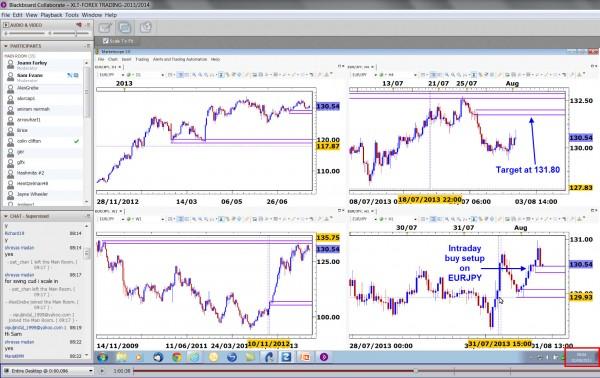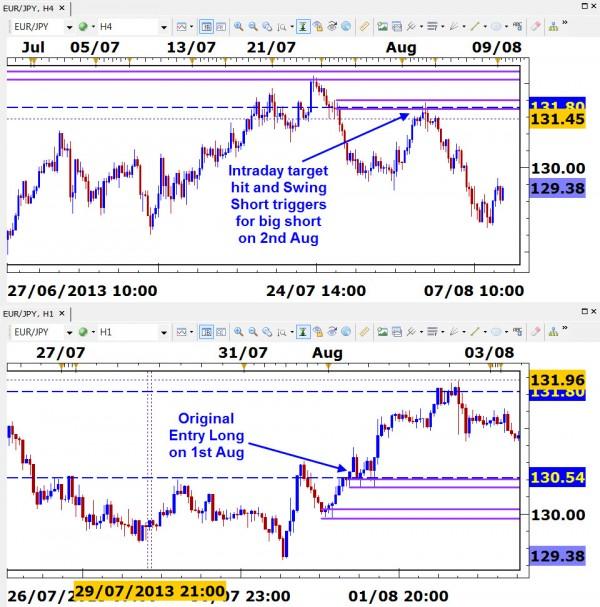![]()
How can you have tea without water, or fish without gills? No I am not trying to be silly or quirky, but instead I would like to make a simple point which is that some things in life are only complete when they are made up of multiple parts or features. For the subject of this week’s trading article, I would like to look at one of the most challenging areas in market speculating which tends to throw many a trader off course from time to time. That is target setting.
As you know, I have taught many fantastic students from around the world in my years as an instructor with Online Trading Academy and mostly, the struggles they have been facing in the market are typically a selection of the same across the board. Setting objective targets and taking profits is probably one of the biggest issues by far. Why do we think this is? Let’s look at some reasons:
1 – Most traders are completely focused on getting into the market more than anything else, because they are constantly worried about missing out on an opportunity or being left on the sidelines while the market goes off without them.
2- Because it is always easy to get in but not so easy to get out! Think about how simple it is to watch the market begin to rally and rush to click that buy button, without any regard or where you think the market is actually going to go to.
3 – Emotion gets in the way of most traders, both seasoned and novice. We can often think too much about what the market is doing with our gut rather than with logical objectivity. These emotions tend to always be at their highest, when a trader is taking on levels of risk which they are not comfortable with in the first place, over leveraged or trading with scared money. Another common issue is when a series of losses have been taken in a row and the trader is desperate to get out of a losing scenario and turn the day or week into a positive one. When they take a trade which then doesn’t become a loser, there is a temptation to take an early profit, before the market “takes it away!” As silly as this may seem, it is a common mistake that we have all done, after all we are only human. Sometimes it can feel like the world is against you after series of losses but this is where correct targets are vital because letting your profits run to those larger targets, is what truly tips the balance of profitability and makes up for the small losses which do happen.
4 – A lack of plan. Many traders fail to put together any kind of real plan to tackle the market on a daily basis. A disciplined and seasoned trader knows that every time they plan and take a trade, they know exactly what their Entry will be, where their Stop is and finally the all important profit Target. In class, we teach this as S.E.T. (Stop, Entry and Target). Emotion has been removed, objectivity is paramount and then we leave the trade and market well alone. I like to reference setting profit targets in trading as being like going on a Day Trip. It would be a pretty pointless exercise to go and get in the car for a trip without actually knowing where you were going to go wouldn’t it? You would just waste your day going around in circles, losing precious time that you could never get back and of course burning fuel for a financial cost as well. Trading is really no different at all. When we place our trades in the currency market or any other asset class, we need to know where we will be getting out if we are on the right side of the market and we need to know this according to the chart well in advance of placing the actual trade. This is all part of the all important trading plan. How many times have you taken profits early on a trade, only to watch the market rise or fall well beyond your exit? Or maybe it was the other way around, where you ran up a huge profit on the trade and did not exit or protect your gains, only to then see it go all the way back to breakeven again? These reasons alone should prove the vital need for solid profit taking in our trading. Let’s take a look at a few setups I did with my students a few weeks ago on my last FX XLT (Extended Learning Track) Live Trading and Analysis session:

This is a snapshot of my XLT screen I share with my students during our live trading and analysis sessions. We are looking at a shot of the EURJPY currency pair. At the time it was just after 9.00am (UK) in the morning on the 1st August. A setup to buy the EURJPY was forming literally as we were looking at the screen in real-time. We had just pulled back to a level of Demand on the hourly chart (see the bottom right chart) at a price of around 130.54 and I instructed the students in the room that this was a low risk place to buy the pair right now, with a stop loss order just below the lower line. This was a classic intraday setup. However, getting in is one thing as we also need to know where to get out. For that, we used the chart in the top right which provided a final target of 131.80, offering us almost 130 pips of reward for just over 15 pips of risk.
The next thing you are probably thinking is why did we go for this target? Simply, because that is what the chart told us to do. If you take a closer look at the chart on the top right, you will notice that the profit target for our buy entry was actually situated at an institutional level of Supply. Knowing for a fact that there was a high probability that prices would fall at this supply area, tells us that this is an ideal time to be out of our long position and switching our thinking to shorting the EURJPY. Let’s see how it worked out:
Prices rallied as expected from our demand area and it actually did not hit the target until the very next day, offering us the ideal opportunity to close the long trade for profit and initial a short for a longer term swing trade. There really is not rocket science or a crystal ball behind this kind of market analysis, just a trust in the charts and a solid plan which tells us what to do and when to do it. The major lesson here is not to show how well the first trade worked out but to really hammer home the importance of taking a profit when the market tells you to. Imagine if you had not closed the long trade and allowed prices to hit the supply area and fall back on you like it did. That’s a real stomach turner for any trader, no matter how seasoned they may be. Pay attention, get your plan in place, know your targets and stick to them. It still surprises me just how hard traders find taking a profit. If you don’t learn to set your targets then why trade at all. After all, I would assume that nobody reading this piece wants to be remembered as the world’s greatest break even trader? I hope this helps for the future.
Note: All information on this page is subject to change. The use of this website constitutes acceptance of our user agreement. Please read our privacy policy and legal disclaimer. Opinions expressed at FXstreet.com are those of the individual authors and do not necessarily represent the opinion of FXstreet.com or its management. Risk Disclosure: Trading foreign exchange on margin carries a high level of risk, and may not be suitable for all investors. The high degree of leverage can work against you as well as for you. Before deciding to invest in foreign exchange you should carefully consider your investment objectives, level of experience, and risk appetite. The possibility exists that you could sustain a loss of some or all of your initial investment and therefore you should not invest money that you cannot afford to lose. You should be aware of all the risks associated with foreign exchange trading, and seek advice from an independent financial advisor if you have any doubts.
Editors’ Picks
EUR/USD edges lower toward 1.0700 post-US PCE

EUR/USD stays under modest bearish pressure but manages to hold above 1.0700 in the American session on Friday. The US Dollar (USD) gathers strength against its rivals after the stronger-than-forecast PCE inflation data, not allowing the pair to gain traction.
GBP/USD retreats to 1.2500 on renewed USD strength

GBP/USD lost its traction and turned negative on the day near 1.2500. Following the stronger-than-expected PCE inflation readings from the US, the USD stays resilient and makes it difficult for the pair to gather recovery momentum.
Gold struggles to hold above $2,350 following US inflation

Gold turned south and declined toward $2,340, erasing a large portion of its daily gains, as the USD benefited from PCE inflation data. The benchmark 10-year US yield, however, stays in negative territory and helps XAU/USD limit its losses.
Bitcoin Weekly Forecast: BTC’s next breakout could propel it to $80,000 Premium

Bitcoin’s recent price consolidation could be nearing its end as technical indicators and on-chain metrics suggest a potential upward breakout. However, this move would not be straightforward and could punish impatient investors.
Week ahead – Hawkish risk as Fed and NFP on tap, Eurozone data eyed too

Fed meets on Wednesday as US inflation stays elevated. Will Friday’s jobs report bring relief or more angst for the markets? Eurozone flash GDP and CPI numbers in focus for the Euro.
RECOMMENDED LESSONS
Making money in forex is easy if you know how the bankers trade!
Discover how to make money in forex is easy if you know how the bankers trade!
5 Forex News Events You Need To Know
In the fast moving world of currency markets, it is extremely important for new traders to know the list of important forex news...
Top 10 Chart Patterns Every Trader Should Know
Chart patterns are one of the most effective trading tools for a trader. They are pure price-action, and form on the basis of underlying buying and...
7 Ways to Avoid Forex Scams
The forex industry is recently seeing more and more scams. Here are 7 ways to avoid losing your money in such scams: Forex scams are becoming frequent. Michael Greenberg reports on luxurious expenses, including a submarine bought from the money taken from forex traders. Here’s another report of a forex fraud. So, how can we avoid falling in such forex scams?
What Are the 10 Fatal Mistakes Traders Make
Trading is exciting. Trading is hard. Trading is extremely hard. Some say that it takes more than 10,000 hours to master. Others believe that trading is the way to quick riches. They might be both wrong. What is important to know that no matter how experienced you are, mistakes will be part of the trading process.

